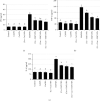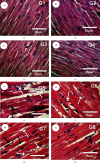Chitosan and Curcumin Nanoformulations against Potential Cardiac Risks Associated with Hydroxyapatite Nanoparticles in Wistar Male Rats
- PMID: 34373695
- PMCID: PMC8349268
- DOI: 10.1155/2021/3394348
Chitosan and Curcumin Nanoformulations against Potential Cardiac Risks Associated with Hydroxyapatite Nanoparticles in Wistar Male Rats
Abstract
Nanoparticle-induced cardiovascular diseases have attracted much attention. Upon entering the blood circulation system, these particles have the potency to induce cardiomyocytes, leading to cardiac failure or myocardial ischemia, and the molecular mechanism remains to be completely clarified. In this study, the cardiac toxicity of rats orally exposed to hydroxyapatite nanoparticles (HAPNPs) has been observed through an increase in myocardial infarction serum markers including CK-MB and alterations in routine blood factors, expression of apoptosis-related protein P53, and increased levels of serum inflammatory markers represented by the tumor necrosis factor alpha and Interleukin-6, as well as a decline in heart antioxidant enzymes and reduced glutathione level, while an induction in lipid peroxidation and nitric oxide has been observed, as well as notable histological and histochemical alterations in the heart of these animals. mRNA and protein expressions of vascular endothelial growth factor (VEGF-A), cyclooxygenase-2 (COX-2), and atrial natriuretic factor (ANF) were elevated in the myocardium. However, the coadministration of chitosan nanoparticles (CsNPs) and/or curcumin nanoparticles (CurNPs) successfully modulated these alterations and induced activation in antioxidant parameters. The present data suggest that HAPNPs-induced apoptosis via the mitochondrial pathway may play a crucial role in cardiac tissue damage and the early treatment with CsNPs and CurNPs may protect the heart from infarction induced by HAPNPs toxic effect.
Copyright © 2021 Israa F. Mosa et al.
Conflict of interest statement
The authors declare that they have no conflicts of interest.
Figures











References
LinkOut - more resources
Full Text Sources
Research Materials
Miscellaneous

